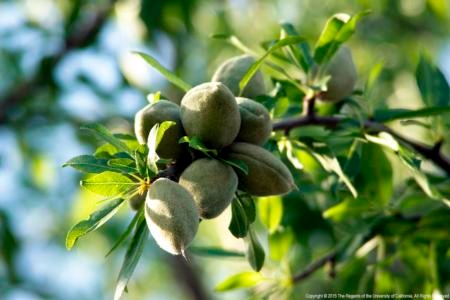Posts Tagged: Sonja Brodt
Recording of life-cycle assessment of tree crops webinar posted
Can orchards get credit for storing carbon? A webinar discussing greenhouse gas emissions, carbon sequestration and more is now online.
Sonja Brodt, academic coordinator in the UC ANR Sustainable Agriculture Research and Education Program, and Elias Marvinney, a graduate student in the UC Davis Department of Plant Sciences, hosted a webinar on July 29 to discuss their life cycle assessment analyzing the environmental impacts associated with walnuts, prunes, peaches, almonds and pistachios. The researchers are quantifying energy use and greenhouse gas emissions in orchard crop production both on the farm and beyond.
Research by the UC Davis and UC Agriculture and Natural Resources scientists found that almonds have a relatively small carbon footprint and could become carbon-neutral or even carbon-negative, largely through incorporating orchard biomass into the soil or using the biomass, hulls and shells for renewable power generation and dairy feed.
To watch a free recording of the Life Cycle Assessment of Greenhouse Gas Emissions and Energy Use in California Orchard Crops webinar, go to http://bit.ly/1ITIbKr.
Brodt and Marvinney co-authored two related articles published in the current issue of Journal of Industrial Ecology examining the environmental impact of the almond industry.
The first article, "Life Cycle-based Assessment of Energy Use and Greenhouse Gas Emissions in Almond Production, Part I: Analytical Framework and Baseline Results," is authored by Alissa Kendall, an associate professor in the UC Davis Department of Civil and Environmental Engineering, Marvinney, Brodt and Weiyuan Zhu, a UC Davis graduate student in horticulture and agronomy.
Marvinney is lead author of the second article, "Life Cycle-based Assessment of Energy Use and Greenhouse Gas Emissions in Almond Production, Part II: Uncertainty Analysis through Sensitivity Analysis and Scenario Testing," in collaboration with Kendall and Brodt.
This research was supported by grants from the Almond Board of California and the CDFA Specialty Crop Block Grant Program.
California almonds have small carbon footprint compared to other protein foods
Research by UC Davis and UC Agriculture and Natural Resources scientists found that almonds have a relatively small carbon footprint, which could be further reduced with advanced management practices.
Two related articles published in the current issue of Journal of Industrial Ecology examine the environmental impact of this agricultural industry. Co-author Alissa Kendall, an associate professor in the UC Davis Department of Civil and Environmental Engineering, and her colleagues noted that certain practices substantially reduce greenhouse gas emissions and energy use, including the strategic use of co-products, and the choice of water source and irrigation technology.
"Our research shows that 1 kilogram of California almonds typically produces less than 1 kilogram of CO2-equivalent emissions, which is a lower carbon footprint than many other nutrient- and energy-dense foods," said Kendall.
“These results include the use of almond co-products — orchard biomass, hulls and shells — for renewable power generation and dairy feed,” said Kendall. “Under ideal circumstances, which are feasible but not in place today, California almonds could become carbon-neutral or even carbon-negative, largely through the improved utilization of orchard biomass."
David Doll, UC ANR Cooperative Extension advisor in Merced County, agrees.
“As California farmers improve their nitrogen and water use efficiencies, they will reduce the carbon footprint,” Doll said. “This will happen as we continue to transition into a nitrogen budgeting system, which will reduce over-applications of nitrogen. Furthermore, on the other end, research conducted by Cooperative Extension has shown that the entire biomass of an orchard can be incorporated back into the soil, which increases the amount of total carbon sequestered.”
“Only a full life cycle-based model like the one we developed for this research will allow us to accurately assess whether incorporating the biomass into the soil or using it for power generation instead results in a lower net carbon footprint,” said Sonja Brodt, academic coordinator in the UC ANR Sustainable Agriculture Research and Education Program, noting that there will be some trade-off.
The first article, "Life Cycle-based Assessment of Energy Use and Greenhouse Gas Emissions in Almond Production, Part I: Analytical Framework and Baseline Results," is authored by Kendall, Elias Marvinney, a graduate student in the UC Davis Department of Plant Sciences; Brodt and Weiyuan Zhu, a UC Davis graduate student in horticulture and agronomy.
Marvinney is lead author of the second article, "Life Cycle-based Assessment of Energy Use and Greenhouse Gas Emissions in Almond Production, Part II: Uncertainty Analysis through Sensitivity Analysis and Scenario Testing," in collaboration with Kendall and Brodt.
This research was supported by grants from the Almond Board of California and the CDFA Specialty Crop Block Grant Program.
Brodt and Marvinney will host a webinar to discuss their life cycle assessment analyzing the environmental impacts associated with walnuts, prunes, peaches, almonds and pistachios. The researchers are quantifying energy use and greenhouse gas emissions in orchard crop production both within and beyond the farm. To join the webinar, visit https://uc-d.adobeconnect.com/orchard-lca at noon on Wednesday, July 29.
The University of California Global Food Initiative aims to put the world on a path to sustainably and nutritiously feed itself. By building on existing efforts and creating new collaborations among UC's 10 campuses, affiliated national laboratories and the Division of Agriculture and Natural Resources, the initiative will develop and export solutions for food security, health and sustainability throughout California, the United States and the world.



